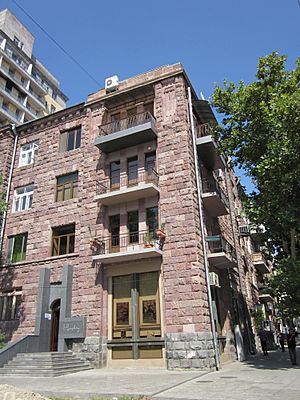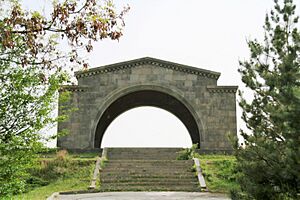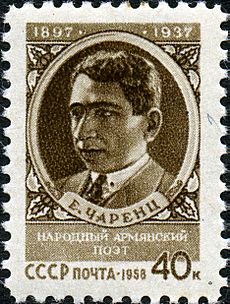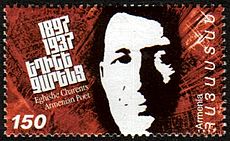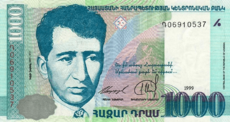Yeghishe Charents facts for kids
Quick facts for kids
Yeghishe Charents
Եղիշե Չարենց |
|
|---|---|
 |
|
| Born | Yeghishe Soghomonyan March 13, 1897 Kars, Kars Oblast, Russian Empire |
| Died | November 27, 1937 (aged 40) Yerevan, Armenian SSR, USSR |
| Resting place | unknown |
| Occupation | Poet, writer, translator, public activist |
| Language | Armenian |
| Nationality | Armenian |
| Spouse | Izabella Charents |
| Children | Anahit Charents and Arpenik Charents |
Yeghishe Charents (Armenian: Եղիշե Չարենց, romanized: Yeghishe Ch’arents’; March 13, 1897 – November 27, 1937) was an important Armenian poet, writer, and public activist. He wrote about many topics, including his experiences in World War I, the Russian Revolution, and especially about Armenia and its people. Many people consider him "the main poet of the 20th century" in Armenia.
Charents first supported communism and the Soviet Union. He joined the Bolshevik Party and actively supported Soviet Armenia. However, he later became unhappy with the way the Soviet Union was run under Joseph Stalin. He was arrested in the 1930s during a time called the Great Purge. He died in 1937 under unclear circumstances. After Stalin's death, Charents was officially cleared of all charges in 1955. This process is called rehabilitation.
Contents
Who Was Yeghishe Charents?
His Early Life and Education
Yeghishe Charents was born Yeghishe Abgari Soghomonyan in Kars in 1897. Kars was then part of the Russian Empire. His family worked in the rug business. They came from an Armenian community in Maku, Persian Armenia.
He first went to an Armenian elementary school. Later, from 1908 to 1912, he attended a Russian technical secondary school in Kars. He loved to read a lot. In 1912, his first poem was published in an Armenian magazine called Patani in Tbilisi.
Joining the War and Revolution
In 1915, during World War I and the Armenian genocide, Charents volunteered to fight. He joined a group on the Caucasian Front. He was sent to Van in 1915. There, he saw the terrible destruction caused by the Turkish army on the Armenian people. These sad memories stayed with him and appeared in his poems later.
He left the front a year later and studied in Moscow. The horrors of war and genocide deeply affected Charents. He became a strong supporter of the Bolsheviks. He believed they were the only hope for Armenia.
Charents joined the Red Army and fought in the Russian Civil War. He fought as a soldier in Russia and the Caucasus. In 1919, he returned to Armenia. He took part in revolutionary activities there. A year later, he started working for the Ministry of Education. He was the director of the Art Department.
In 1920-1921, he wrote one of his most famous poems, I love the sun-sweet taste of the fruits of Armenia. This poem is a beautiful tribute to his homeland.
His Literary Journey
Charents went back to Moscow in 1921 to study literature. In 1922, he and two other young writers, Gevorg Abov and Azad Veshtuni, wrote a statement. It was called the "Declaration of the Three." In it, they supported "proletarian internationalism," which means workers from all countries should unite.
He wrote "Amenapoem" and "Charents-name'," which was about his own life. Then, Charents published his funny novel, Land of Nairi (Yerkir Nairi). It was very popular and was published many times in Russian. In 1934, the famous writer Maxim Gorky praised Charents and his book.
The first part of Yerkir Nairi describes people and places in Kars. It also shows Armenian public life. Charents said his Yerkir Nairi was "an incomprehensible miracle." The second part of the novel shows Kars during World War I. The third part tells about the fall of Kars and the end of a dream.
From 1924 to 1925, Charents traveled for seven months. He visited Turkey, Italy, France, and Germany. In Italy, he met another famous Armenian poet, Avetik Isahakyan. When he returned, he started a writers' group called November. He also worked for the state publishing house from 1928 to 1935.
In 1930, Charents's book, "Epic Dawn," was published. It contained poems he wrote between 1927 and 1930. He dedicated this book to his first wife, Arpenik.
His last collection of poems, "The Book of The Way," was printed in 1933. But the Soviet government delayed its release until 1934. In this book, Charents explored Armenian history. The American writer William Saroyan met him in 1934. Saroyan described Charents as a brilliant but very sad man.
Charents also translated many works into Armenian, including "The Internationale."
His Final Years and Legacy
Challenges and Death
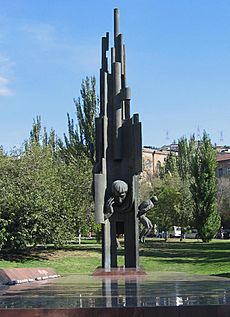
After 1934, Charents could publish very few poems in journals. In July 1936, after the Soviet Armenian leader Aghasi Khanjian was killed, Charents wrote a series of seven sonnets. He also wrote one of his last great works, "Requiem Æternam in Memory of Komitas" (1936), after the death of the famous musician Komitas.
Charents was accused of "counterrevolutionary and nationalist activity." He was put in prison during the Great Purge. He died on November 29, 1937, under unclear circumstances. No one knows where his body was buried. All his books were also banned at that time. Charents' younger friend, Regina Ghazaryan, bravely hid and saved many of his writings.
Family Life
Charents' first wife was Arpenik Ter-Astvadzatryan, who passed away in 1927. In 1931, Charents married Izabella Kodabashyan. They had two daughters, Arpenik and Anahit, who was born in 1935.
Remembering Charents
After Stalin's death, Anastas Mikoyan spoke in Yerevan in 1954. He asked for Charents to be officially cleared of charges. This led to Charents' official rehabilitation on March 9, 1955.
In 1975, Charents' home in Yerevan was turned into the Yeghishe Charents House-Museum. The Armenian city of Charentsavan was also named after him.
After his rehabilitation, the Soviet authorities released a stamp honoring Charents in 1958. The Republic of Armenia also issued a stamp and a coin in 1997. The 1000 dram banknote in Armenia features Charents and a famous line from one of his poems: (Armenian) "Ես իմ անուշ Հայաստանի արեւահամ բարն եմ սիրում" (I love the sun sweet taste of Armenia). In 2016, Pope Francis even recited a part of this poem during his visit to Armenia.
Translations and Studies
Many famous writers translated Charents' works. These include Valeri Bryusov, Anna Akhmatova, Boris Pasternak, and Louis Aragon. William Saroyan wrote a short story about Charents in his 1971 book.
The first book about Charents was published in 1924 by Simon Hakobyan. After Charents' death, his works and studies about him were banned for 17 years. In 1954, Norayr Dabaghyan published a book called Yeghishe Charents. Later, many other researchers also studied his poetry.
Marc Nichanian's book Writers of Disaster has a chapter about Charents' poetry. The book Charents: Poet of the Revolution has many articles about different parts of his work. Krikor Beledian's book Haykakan futurizm (Armenian Futurism) looks at how Futurism developed in Armenian communities, including Charents' role.
His Main Works
- "Three songs to the sad and pale girl...", poems (1914)
- "Blue-eyed Homeland", poem (1915)
- "Dantesque legend", poem (1915–1916)
- "Soma", poem (1918)
- "Charents-Name", poem (1922)
- "Uncle Lenin", poem (1924)
- "Country of Nairi" (Yerkir Nairi) (1926)
- "Epical Sunrise", poems (1930)
- "Book of the Way", poems (1933–34)
See also
 In Spanish: Yeghishe Charents para niños
In Spanish: Yeghishe Charents para niños


